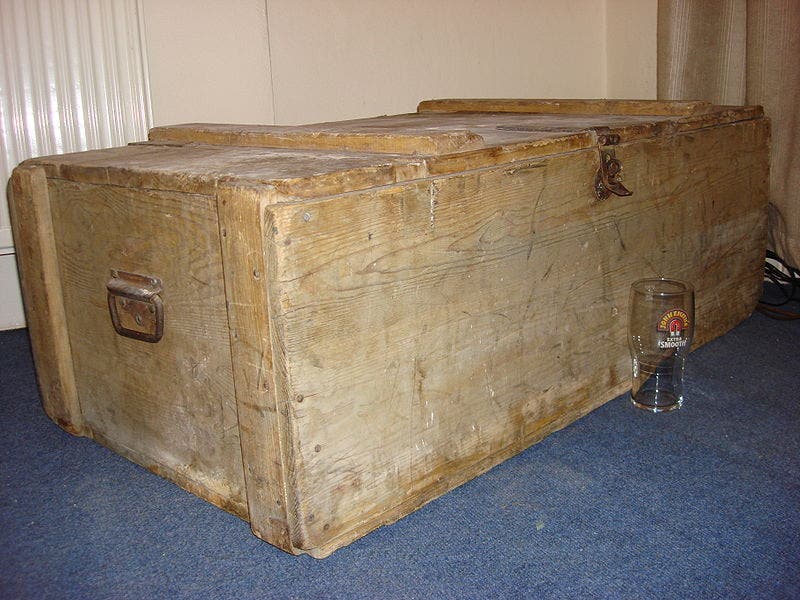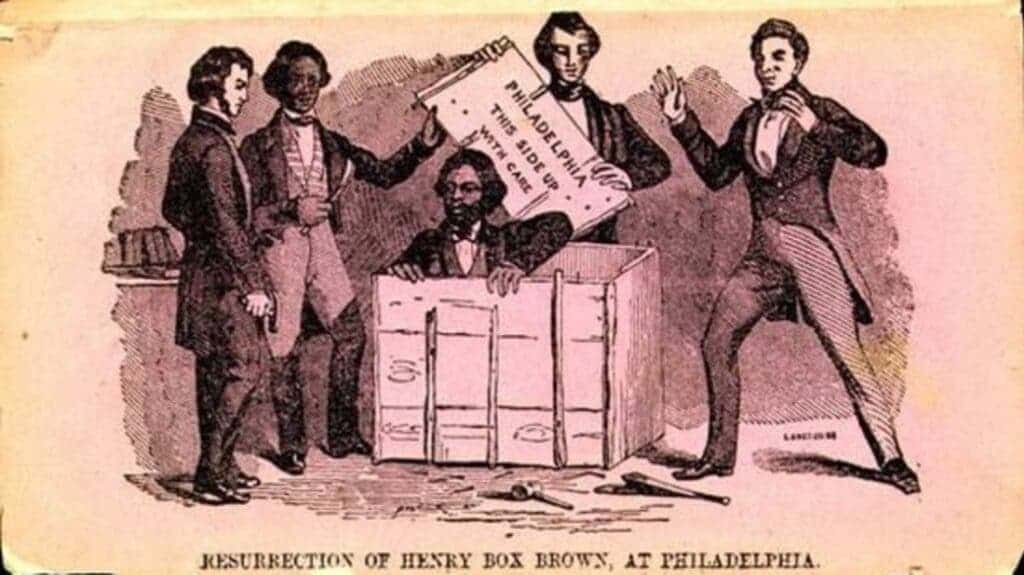When Brian Robson posted himself from Australia to the UK, he was probably lucky he was discovered in the US. After a journey that took four days, with the box repeatedly being stored upside down, Robson was found and sent back by US postal workers — the “normal” way.
But others managed to complete the feat, and their stories are maybe even crazier.

Thinking inside the box
Robson, now 75, admits it was a “stupid” plan. But he was 19 and homesick. Working in Australia took a toll on him, and the flight back would have been £700 — and he only made £40 a month, he told the Irish Times.
“If my kids tried it, I would kill them. But it was a different time.”
So Robson posted himself from Australia to the UK. He bought a box “the size of a mini-fridge” and packed it with what he thought was essential for the trip: pillows, a suitcase, two bottles (one for water, one for urine), and a book of Beatles songs — he also had a pair of pliers to pull the nails out on arrival in London. Two friends then nailed it shut and booked him a one-way flight from Melbourne to London.
“I could fit in there OK as long as I sat down with my knees pressed up in my chest. My back was to the suitcase. It was quite large, which obviously reduced my movements inside even more,” he recalled.
“I couldn’t stretch my legs and I couldn’t turn around,” he says. “I was more or less stuck in that position, which at first was quite comfy but later proved not so sensible.”

He may have gotten away with it (or may have suffered a tragic fate) had his flight not been full. As a result, Robson and his box were transferred to a PanAm flight that took him to Los Angeles — where he was discovered and understandably grilled by the FBI.
The worker who spotted him looked through a hole in the box and, as Robson recalls, the two looked straight into each other’s eyes.
“He jumped back a mile and said, ‘There’s a body in there.’”
Eventually, after criticism from the Australian, American, and British governments, Robson was sent back to the UK to continue his life there. It was a “horrific experience”, Robson recalls. It took four days and he had been repeatedly stored upside down.
Robson is now looking for the two friends who helped him nail the box down, to thank them.
Escaping slavery via mail
The first recorded successful attempt was accomplished by Henry Brown in 1849. Brown, then a slave, famously escaped to freedom mailed in a wooden crate in 1849, sent from Richmond, Virginia, to abolitionists in Philadelphia. The feat was so well-known that he became known as Henry “Box” Brown. But it wasn’t easy.

Brown relied on the help of a free black man and a sympathetic white shoemaker to get his plan to fruition. He burned his hand to the bone with acid to escape from work that day and shipped himself in a box 3 by 2.67 by 2 feet (0.91 by 0.81 by 0.61 m) with the words “dry goods” displayed on it. The box was lined with baize, a coarse woolen cloth, and he carried only a small portion of water and a few biscuits. There was a single hole cut for air.
Brown wasn’t sure that the method was worth the risk, but he recalls:
“If you have never been deprived of your liberty, as I was, you cannot realize the power of that hope of freedom, which was to me indeed, an anchor to the soul both sure and steadfast.”
Brown was awaited by people who were aware of his plan. When he was released, his first words were “How do you do, gentlemen?” He then sang a psalm from the Bible to celebrate his freedom.
The feat was hailed as a show of strength of the US mail. Brown became a performer and published two versions of his autobiography. Some regretted this, as Brown described his feat in great detail — and when others tried to escape to freedom using the same method, they were apprehended. Brown’s helper was also arrested for attempting another shipment of slaves.
A few more successful attempts
Very few long-distance human mail attempts have been successful — for adults, that is; as we’ll see in a minute, mailing children was a bit more common. Among these very few, that of Reg Spiers stands out.
At over 2 meters (6.5 feet) tall, Reg Spiers isn’t the first person who’d come to mind when it comes to human mail. He was a professional javelin thrower. Unfortunately, Spiers’ results weren’t enough to qualify him for the Olympics. He made a desperate attempt, traveling from Australia to England in 1964, attempting to qualify during the English summer. He was yet again unsuccessful. Desperate, penniless, and eager to get back home in time for his daughter’s birthday, Spiers tried one last-ditch attempt. He had a fellow javelin thrower build him a man-sized box and freighted himself back to Australia.
Not much is known about his 63-hour journey, in large part because Spiers later became a fugitive for drug smuggling and did not give any interviews. But we do know that Spiers managed to get out of the box and spent some time outside his container in the cargo hold of the plane and was severely dehydrated by the time he made it back to Perth, Australia.
Spiers won the Australian javelin throwing championship two more times. However, after retiring, he became involved in drug smuggling. He was sentenced to ten years in prison but escaped and fled Australia. He was later captured in India but again escaped, only to be captured in India two years later. Another two years later, he was arrested in Sri Lanka, again for attempting to smuggle drugs. He was initially sentenced to the capital punishment, but a successful appeal changed his sentence to five years in jail. After being a successful athlete, after mailing himself for almost 4 days, and being on the run with his girlfriend on three continents, Spiers is now a free man. His misadventures are detailed in a book.
W. Reginald Bray's attempts aren't quite as impressive as those of Spiers -- but there's two of them. Bray mailed himself within England by ordinary mail in 1900 and then by registered mail in 1903. The English eccentric claimed to be testing the limits of the British mail.
Another notable human mail event took place in 1909, when suffragettes Elspeth Douglas McClelland and Daisy Solomon mailed themselves successfully to the office of then Prime Minister -- but the letter was not accepted.
An inmate in Germany also put the mail to good use in 2008. He had been making stationery with other prisoners destined for the shops, and decided to jump into one box himself. A courier picked up the box and took it outside, where the man's accomplices were allegedly waiting. It's unclear if the escapee was ever apprehended.
Sandra De los Santos, a law student in Havana was also successful in her daring attempt. Upon taking a vacation in the Bahamas, she stuffed herself into a wooden box that was shipped to the US. She had only a mobile phone and a jug of water with her. She was discovered in Miami, but was granted asylum and allowed to stay in the US, as she would have risked persecution upon returning to Cuba.
... and a couple unsuccessful ones
Of course, many (most?) attempts don't succeed. In 2003, Charles McKinley attempted to ship himself from New York City to Dallas, Texas in a box. He was attempting to save flight costs and charge the shipping fees to his former employer -- but was discovered.
In 2012, a man in Chongqing, China, wanted to surprise his girlfriend and shipped himself in a box. But the box had no air, and the prank almost turned fatal when the courier took more than expected (three hours). The man was unconscious and had to be revived by paramedics.
However, mailing oneself is very risky and should never be attempted. I cannot emphasize this enough: please don't try to ship yourself as a package. Sure, it may sound fun, but there are actual dangers, and you'll only cause trouble for everyone -- including yourself. The danger is very real.
According to some unverified claims, some 40-50 people get killed every year trying to mail themselves. While such claims are doubtful, it's easy to imagine such a stunt going wrong. With the rise of new viral internet challenges, it's important to be aware of such dangers.
Mailing children

A special mention is needed for mailing children. This unfortunate practice emerged in the US in the early days of the post office, when offices began accepting parcels over four pounds on January 1, 1913. It wasn't necessarily a common practice, but at least several cases are recorded.
For parents, this was cheaper than a train ticket, and in many areas, people knew their post officer quite well and trusted them. Edna Neff of Pensacola, Florida, was 6 when she was packed off to her father’s home in Christiansburg, Virginia, 720 miles away. Neff recalled the story for a Washington Post podcast.
Four-year-old May Pierstorff of Grangeville, Idaho, was set to visit her grandparents 75 miles away, but her parents didn't want to pay the large train fare. Instead, they checked a "package" and paid a fraction for it. They attached the postal stamps to May's coat and labeled the shipment as a "baby chick". May rode in the train's mail compartment and was hand-delivered to her grandparents. May's story was the subject of a 1997 book, Mailing May.
The children weren't placed in boxes, but even so, the practice was, at the very least, very questionable. It wasn't so much that the post office allowed this -- rather, it didn't have any explicit rules against it. The only clear rule was that the packages had a max weight, which restricted the practice to children and not adults. That was rectified within a year or so, however, and children were not shipped via mail anymore.
Please don't do it
Instead of an ending, we thought we'd emphasize just how dangerous the practice of human mail is.
Seriously, just don't do it.



